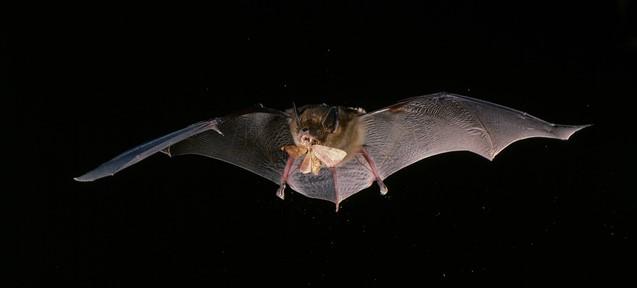Description and Range
Physical description
The big brown bat is one of the largest bat species in Washington and features a heavy body, large head, and broad nose. The fur varies from pale to dark brown, is darker above and lighter below, and has an oily texture. Individual hairs on the back are relatively long and extend one-quarter of the way down the upper surface of the tail membrane. Wing membranes and ears are black. Ears are relatively rounded and short, and barely reach the nose when pressed forward.
Food habits and foraging
The large, powerful jaw musculature and heavy teeth of big brown bats allow them to feed on hard-bodied insects as well as other prey. Beetles typically form the bulk of their diet, while moths, termites, true bugs, leafhoppers, flies, and flying ants are other main foods. Other regional studies have found preferences for caddisflies, bees, and ants.
Reproduction
Pregnancy lasts about 60 days. Births occur from May to August. Litter size is usually one pup in Western North America.
Geographic range
Big brown bats range from southern and central Canada to northern South America and the Caribbean. This species is present throughout Washington. The big brown bat is a habitat generalist that occupies a variety of forest types, rangeland, and urban areas. In Washington and Oregon, the species appears to be more common in forest than shrubsteppe and alpine areas. Occurrence in the West extends from sea level to 3,800 meters in elevation. In mountainous areas, males inhabit higher elevations than females.
Roosting
Summer day roosts of this species, including maternity colonies, occur in a variety of settings, including buildings (e.g., inside attics and walls), trees, snags, caves, mines, crevices in cliffs, and bridges. Reproductive females are colonial and occupy sites offering suitable temperature gradients. Maternity roosts are often in older buildings having appropriate entry points or in large live or dead trees in intermediate stages of decay. Occupation of trees and snags depends on the presence of cavities, hollow trunks, crevices, loose exfoliating bark, and dead or broken tops; cavity volume; openness from surrounding vegetation; and older age of the forest stand. Ponderosa pine, aspen, and Douglas-fir are among the main tree species used for roosting.
Maternity roosts in the West usually contain anywhere from about a dozen to several hundred individuals, but in other regions, females sometimes roost in smaller groups or alone. Buildings offer greater safety from predators and warm microclimates, resulting in earlier births, faster juvenile growth, and increased energy savings, and therefore are probably preferred as roosts over some types of natural sites. Most adult females return to the same maternity roost or roost area in successive years.
Hibernation
Hibernacula (place where an animal spends their winter) include buildings, caves, mines, and rock crevices but the extent that other natural sites (e.g., hollow trees) are used is poorly known. Hibernacula generally have air temperatures of 0-18°C (32-64°F). Some winter sites also function as maternity roosts in summer.
Swarming behavior occurs at mines and caves before hibernation. Hibernation lasts from November to April. Hibernacula rarely hold more than a few hundred individuals with those present usually roosting alone or in small clusters of fewer than 20 animals. Both sexes hibernate together. Individuals may lose 25% of their pre-hibernation body weight over winter, thus failure to accumulate sufficient fat reserves can be a major mortality factor, particularly for juveniles. Movement among hibernacula is common within a winter.
Conservation
- Protection of maternity roosts and sizeable hibernacula is a priority for conservation.
- For tree-dwelling populations, retention and recruitment of large snags, decadent trees, and hollow trees is important.
- On intensively managed forests, management agreements and incentives for protecting large-diameter roost trees are desirable. Maintaining remnant patches of structurally diverse forest with abundant large snags is another protective strategy.
- Providing roost structures within 2-3 km of open water or riparian areas is probably beneficial by providing ready access to drinking and foraging sites.
- Maintaining potential roosts across a variety of topographical positions is also desirable so that bats have a range of suitable roosting sites to select from.
- Where eviction from buildings is necessary, appropriate actions should be taken to minimize negative impacts to the bats.
- Precautions to reduce disturbance should be taken when mine and cave surveys are conducted during the breeding season and winter hibernation.
Preventing conflict
For some people bats don't present a problem. For others, bats can be a worry, especially when they become unwanted guests in an attic, inside a wall of a home, or inside the home itself.
Unlike rodents, bats only have small teeth for eating insects, so they do not gnaw holes in walls, shred material for nests, chew electrical wiring, or cause structural damage to buildings. Damage caused by bats is usually minimal, but they can be noisy and alarming, and the smell of bats and their droppings can be offensive. It is possible to learn to coexist with bats, and to benefit from their presence. Learn more on our Living with Wildlife: Bats webpage.
